View in other NatureServe Network Field Guides
NatureServe
Montana
Utah
Wyoming
Idaho
Wisconsin
British Columbia
South Carolina
Yukon
California
New York
A Sand-dwelling Mayfly - Homoeoneuria alleni
State Rank Reason (see State Rank above)
This sand-dwelling mayfly is currently ranked S2 in Montana, because it is at risk of extirpation in the state due to very limited and/or potentially declining population numbers, range and/or habitat.
General Description
This burrowing (body-type & behavior) mayfly is an inhabitant of large, warmwater turbid rivers with shifting sand/gravel substrates and depositional silted habitat areas. This species is a filtering collector feeder, and has long hairs on its fore-legs to perform this filtering-function.
Phenology
Adults of a similar species in this genus were observed from June to October, larvae were collected from May to October. It is believed that this species is univoltine and may over-winter as eggs.
Diagnostic Characteristics
This burrowing mayfly can appear whitish to almost transparent in color with dark bands on the dorsal part of the abdomen. The adults are characterized by the absence of wing crossviens on both wings.
Species Range
Montana Range
Range Descriptions
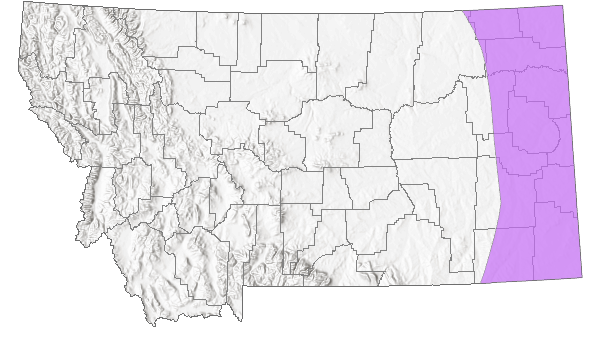
 Native
Native
Range Comments
Rangewide, H. alleni is known to occur in Saskatchewan and the Intermountain West (CO, MT, NM, UT). In Montana, H. alleni has been reported from 7 sites on the Powder River and 1 site in the lower Yellowstone River (Stagliano 2006; Gustafson unpublished data).
Observations in Montana Natural Heritage Program Database
Number of Observations: 16
(Click on the following maps and charts to see full sized version)
Map Help and Descriptions
Relative Density
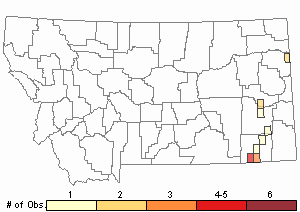
Recency
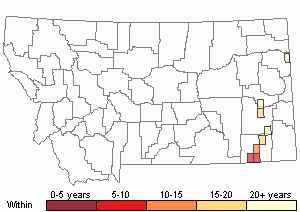

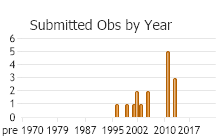
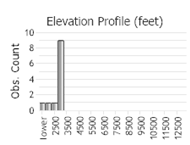 (Observations spanning multiple months or years are excluded from time charts)
(Observations spanning multiple months or years are excluded from time charts)
Migration
This species is not known to migrate, although the adults typically fly upstream when they hatch as most river-dwelling insects do.
Habitat
This species is associated with and digs its burrows within the sandy/silted depositional areas of larger, perennially flowing prairie rivers with sand-gravel dominated bottoms.
Food Habits
This species is a filtering collector, sifting and eating small-medium sized organic particles from the water flowing over its burrow.
Management
Maintaining natural flow regime conditions (no dams or diversions) that allow for the persistence of the shifting sand and gravel habitats preferred by this species.
Stewardship Responsibility
Threats or Limiting Factors
Threats to this species include dams and diversions altering flow patterns and excessive siltation that can smother their sandy bottom habitats. Stagliano (2012) reported on the short-term population declines of this species in the Powder River while monitoring aquatic communities between 2005 and 2012, the height of Wyoming’s coal bed natural gas production.
References
- Literature Cited AboveLegend:
 View Online Publication
View Online Publication Stagliano, D.M. 2006. Aquatic surveys and assessment within the Middle Powder River watershed. Report to the USDI Bureau of Land Management, Miles City Field Office. Montana Natural Heritage Program, Helena, MT. 20 pp. plus appendices.
Stagliano, D.M. 2006. Aquatic surveys and assessment within the Middle Powder River watershed. Report to the USDI Bureau of Land Management, Miles City Field Office. Montana Natural Heritage Program, Helena, MT. 20 pp. plus appendices.
- Additional ReferencesLegend:
 View Online Publication
View Online Publication
Do you know of a citation we're missing? Stagliano, D.M. 2016. Mayflies (Insecta: Ephemeroptera) of conservation Concern in Montana: Status Updates and Management Needs. Western North American Naturalist 76(4):441-451.
Stagliano, D.M. 2016. Mayflies (Insecta: Ephemeroptera) of conservation Concern in Montana: Status Updates and Management Needs. Western North American Naturalist 76(4):441-451.
- Web Search Engines for Articles on "A Sand-dwelling Mayfly"
- Additional Sources of Information Related to "Insects"





